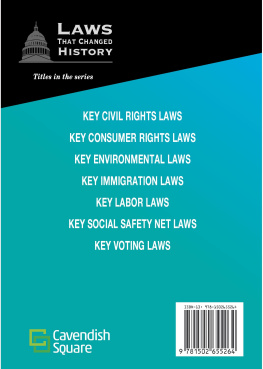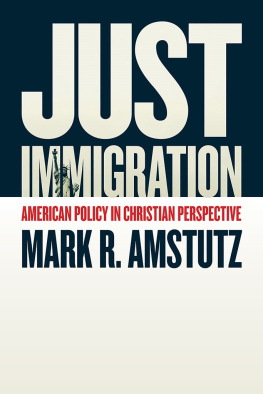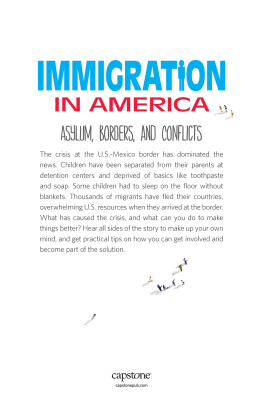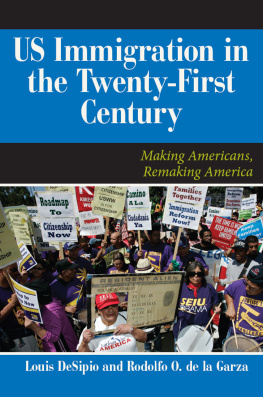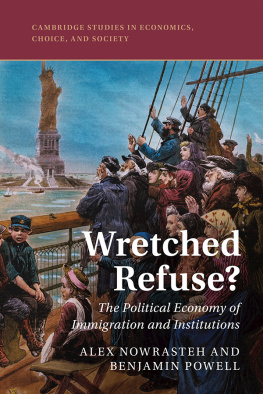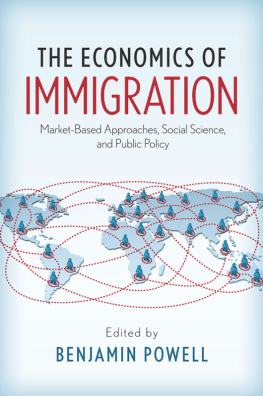Contents
Figures
Tables
Text boxes
Guide
Pages

Immigration & Society series
Carl L. Bankston III, Immigrant Networks and Social Capital
Stephanie A. Bohon and Meghan Conley,Immigration and Population
Thomas Faist, Margit Fauser, and Eveline Reisenauer,Transnational Migration
Christian Joppke, Citizenship and Immigration
Grace Kao, Elizabeth Vaquera, and Kimberly Goyette,Education and Immigration
Nazli Kibria, Cara Bowman, and Megan OLeary,Race and Immigration
Peter Kivisto, Religion and Immigration
Ronald L. Mize and Grace Pea Delgado,Latino Immigrants in the United States
Philip Q. Yang, Asian Immigration to the United States
Immigration and Population
Stephanie A. Bohon
Meghan Conley
polity
Copyright Stephanie A. Bohon and Meghan Conley 2015
The right of Stephanie A. Bohon and Meghan Conley to be identified as Author of this Work has been asserted in accordance with the UK Copyright, Designs and Patents Act 1988.
First published in 2015 by Polity Press
Polity Press
65 Bridge Street
Cambridge CB2 1UR, UK
Polity Press
350 Main Street
Malden, MA 02148, USA
All rights reserved. Except for the quotation of short passages for the purpose of criticism and review, no part of this publication may be reproduced, stored in a retrieval system, or transmitted, in any form or by any means, electronic, mechanical, photocopying, recording or otherwise, without the prior permission of the publisher.
ISBN-13: 978-0-7456-8900-5
A catalogue record for this book is available from the British Library.
Library of Congress Cataloging-in-Publication Data
Bohon, Stephanie.
Immigration and population / Stephanie A. Bohon, Meghan E. Conley.
pages cm
ISBN 978-0-7456-6415-6 (hardback) -- ISBN 978-0-7456-6416-3 (paperback) 1.
Emigration and immigration--Social aspects. 2. Population geography. 3. Demography.
I. Conley, Meghan E. II. Title.
JV6225.B6487 2015
304.8--dc23
The publisher has used its best endeavours to ensure that the URLs for external websites referred to in this book are correct and active at the time of going to press. However, the publisher has no responsibility for the websites and can make no guarantee that a site will remain live or that the content is or will remain appropriate.
Every effort has been made to trace all copyright holders, but if any have been inadvertently overlooked the publisher will be pleased to include any necessary credits in any subsequent reprint or edition.
For further information on Polity, visit our website: politybooks.com
To the tired, the poor, the huddled, the wretched, and the homeless who have journeyed to US shores for nearly 250 years.
Acknowledgements
No book could be completed without the support of many people. We are indebted to Peter Fernandez and to Michael Jarrett, who died a few months prior to the completion of this project. Their constant encouragement sustained us. We would also like to thank Dr. Jon Shefner and the faculty of the Department of Sociology at the University of Tennessee, who provided considerable instrumental support. We are grateful to the staff at Polity, especially Commissioning Editor Jonathan Skerrett, and Editorial Assistant Elen Griffiths, who gave us guidance on the direction of our writing and patiently handled our lives disasters. Finally, we gratefully acknowledge the helpful comments of Dr. Bridget Gorman (Rice University), Dr. Rebecca Clark (NICHD), and Dr. Carmel Price (Furman University).
The Demography of Immigration
Reyna works at a grocery store in a small town in the Appalachian Mountains. An immigrant of Turkish descent, she entered the United States about 10 years ago. Although her foreign accent is unmistakable, Reyna speaks fluent English, and she is polite and pleasant to her customers. Having worked her way up from an entry-level position, she is currently training to manage her own store in the grocerys chain, and she has just purchased her first home.
Much about Reynas story epitomizes the classic stereotype of the hardworking immigrant striving for a better life in a new country. At the same time, her story also illustrates todays complicated global web of international migration, in which place of birth and ethnic identity often differ and immigrants sometimes have experiences of living in three or more countries. For example, Reyna often returns to Turkey to visit relatives, but she was not born in Turkey, nor has she ever lived there. Reyna was born in Germany, where Turks are the largest ethnic minority and comprise about 5 percent of the German population (en 2003). Reyna is one of nearly 43 million immigrants living in the United States and one of nearly 49 million Americans who are associated with GermanUS immigration either by immigrating directly from Germany or by being the descendants of German immigrants. Yet, she is not German. She is one of only a relatively small number of US immigrants of West Asian / Middle Eastern descent (United Nations 2011).
The story of people like Reyna underscores that there is no universal immigrant experience in todays globalized world; rather, there are as many immigrant experiences as there are immigrants. Despite this, there are important trends in immigration, and immigrants share several characteristics. First, many people today live in a country other than the one where they were born. Most of these immigrants reside in the developed world (nearly 128 million in 2009) in the 34 wealthiest countries that comprise the Organization for Economic Co-operation and Development (OECD). OECD countries are home to nearly 60 percent of all immigrants. In fact, about 9 percent of the population of OECD countries is comprised of immigrants, although immigrants comprise only 3 percent of the worlds total population (United Nations 2011). Most immigrants migrate to developed countries from other developed countries; increasingly, however, immigrants are also migrating to developed countries from developing countries (OECD 2007). The developing world is also home to a smaller but still sizable number of immigrants (just over 86 million in 2009: United Nations 2011). This book focuses exclusively on immigration to developed countries, especially emphasizing the United States, which is the worlds biggest immigrant receiver.
Second, immigration typically flows along network lines shaped by cultural, geographic, and historical conditions (Gurak and Caces 1992; McKenzie and Rapoport 2010). Thus, many people from the Middle East immigrate to the European Union, especially France and Germany, but far fewer Middle Easterners immigrate to the United States (Foad 2010). At the same time, many Asian immigrants settle in English-speaking countries, and there are large East and Southeast Asian populations in the United Kingdom, United States, Canada, and Australia. Network migration also explains why immigrants end up in some parts of a host country instead of others. For example, in the early 1900s, the demand for sheepherders resulted in the migration of many people from the Pyrenees Basque Country of Spain and France to southern Idaho; today, Idaho is home to the largest population of Basque people outside of their homeland (Bieter and Bieter 2004).
Third, immigrants are not the same as those they leave behind (Kennedy, McDonald, and Biddle 2006; Belot and Hatton 2012). The process of immigration is difficult and it requires considerable financial, intellectual, and physical capital, as well as a willingness to take risks. For example, immigrants tend to be slightly better educated than the non-immigrants they leave behind (Feliciano 2005). Also, the further immigrants migrate, the greater the



